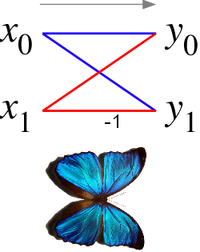
In the context of fast Fourier transform algorithms, a butterfly is a portion of the computation that combines the results of smaller discrete Fourier transforms (DFTs) into a larger DFT, or vice versa (breaking a larger DFT up into subtransforms). The name "butterfly" comes from the shape of the data-flow diagram in the radix-2 case, as described below.[1] The earliest occurrence in print of the term is thought to be in a 1969 MIT technical report.[2][3] The same structure can also be found in the Viterbi algorithm, used for finding the most likely sequence of hidden states.
Most commonly, the term "butterfly" appears in the context of the Cooley–Tukey FFT algorithm, which recursively breaks down a DFT of composite size n = rm into r smaller transforms of size m where r is the "radix" of the transform. These smaller DFTs are then combined via size-r butterflies, which themselves are DFTs of size r (performed m times on corresponding outputs of the sub-transforms) pre-multiplied by roots of unity (known as twiddle factors). (This is the "decimation in time" case; one can also perform the steps in reverse, known as "decimation in frequency", where the butterflies come first and are post-multiplied by twiddle factors. See also the Cooley–Tukey FFT article.)
- ^ Alan V. Oppenheim, Ronald W. Schafer, and John R. Buck, Discrete-Time Signal Processing, 2nd edition (Upper Saddle River, NJ: Prentice Hall, 1989)
- ^ C. J. Weinstein (1969-11-21). Quantization Effects in Digital Filters (Report). MIT Lincoln Laboratory. p. 42. Archived from the original on February 11, 2015. Retrieved 2015-02-10.
This computation, referred to as a 'butterfly'
- ^ Cipra, Barry A. (2012-06-04). "FFT and Butterfly Diagram". mathoverflow.net. Retrieved 2015-02-10.